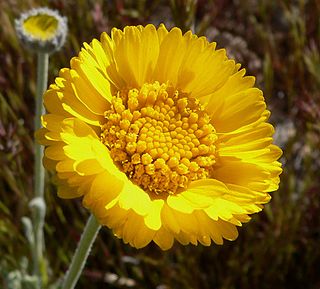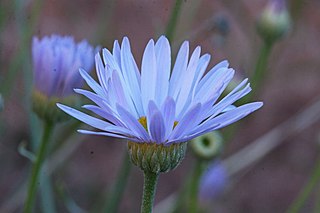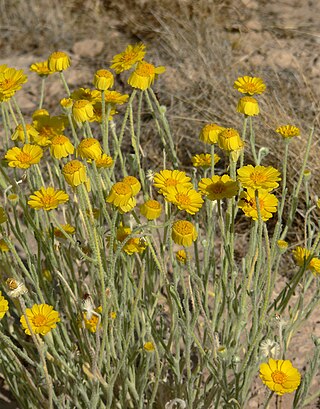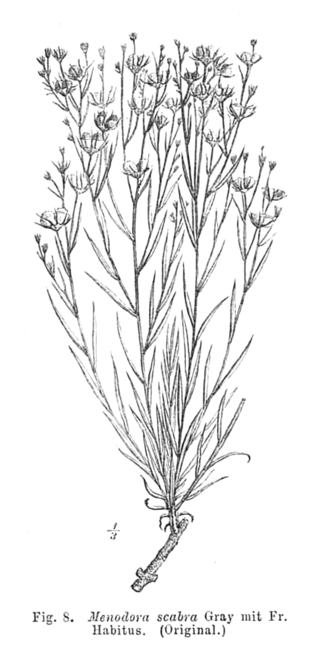
Rubus leucodermis, also called whitebark raspberry, blackcap raspberry, or blue raspberry, is a species of Rubus native to western North America.

Baileya is a genus of plants in the aster family Asteraceae. All are native to the southwestern United States and to Mexico.

Nolina parryi is a flowering plant that is native to Baja California, southern California and Arizona.

Chaenactis xantiana, the Mojave pincushion or Xantus pincushion, is a flowering plant in the family Asteraceae, native to the western United States, from southeastern Oregon, Nevada, southern and eastern California and northwestern Arizona. It is very common in the Antelope Valley in the Mojave Desert, and grows in sandy soils.

Calycoseris parryi, the yellow tackstem, is a spring wildflower found in the Mojave Desert, the Sonoran Desert, and surrounding regions of the southwestern United States and northwestern Mexico. It is found in California, Nevada, Utah, Arizona, and Baja California.

Ericameria nauseosa, commonly known as chamisa, rubber rabbitbrush, and gray rabbitbrush, is a shrub in the sunflower family (Aster) found in the arid regions of western North America.

Erigeron divergens is a species of flowering plant in the family Asteraceae known by the common name spreading fleabane. It is native to western North America.

Cirsium neomexicanum is a North American species of thistle known by the common names New Mexico thistle, powderpuff thistle, lavender thistle, foss thistle and desert thistle.

Erigeron utahensis is a North American species of flowering plant in the family Asteraceae known by the common name Utah fleabane.

Calycoseris wrightii, commonly known as white tackstem, is an annual spring wildflower, one of two species in the genus Calycoseris; the other species is C. parryi, the yellow tackstem. They are part of the family Asteraceae.

Agoseris glauca is a species of flowering plant in the family Asteraceae known by the common names false dandelion, pale agoseris, prairie agoseris, and short-beaked agoseris. It is native to western North America.

Baileya pauciradiata is a species of flowering plant in the daisy family, Asteraceae. It is known by the common names laxflower and Colorado desert marigold. It is native to the deserts of northwestern Mexico and the southwestern United States. It has been found in the States of California, Arizona, Nevada, Baja California, and Sonora.

Baileya pleniradiata is a North American species of flowering plant in the daisy family, Asteraceae. It is known by the common name woolly desert marigold. It is native to desert regions of the southwestern United States and northern Mexico, where it grows in sandy habitats. It has been found in the States of Chihuahua, Sonora, Baja California, Arizona, Utah, and Nevada.

Balsamorhiza sagittata is a North American species of flowering plant in the tribe Heliantheae of the family Asteraceae known by the common name arrowleaf balsamroot. Also sometimes called Oregon sunflower, it is widespread across western Canada and much of the western United States.

Malacothrix glabrata, commonly known as the smooth desert dandelion or desert dandelion, is an annual plant with yellow flowers that appears in western North America.

Enceliopsis nudicaulis is a North American species of flowering plants in the family Asteraceae known by the common name nakedstem sunray, or naked-stemmed daisy.

Rafinesquia neomexicana is a species of flowering plant in the family Asteraceae. Common names include desert chicory, plumeseed, or New Mexico plumeseed. It has white showy flowers, milky sap, and weak, zigzag stems, that may grow up through other shrubs for support. It is an annual plant found in dry climate areas of the southwestern deserts of the US and northwestern deserts of Mexico.

Malacothrix coulteri is a species of flowering plant in the family Asteraceae. It is known by the common name snake's head or snake's head desert-dandelion.

Menodora scabra is broom-like shrub in the Olive Family (Oleaceae), known by the common name rough menodora or broom twinberry. It is a popular desert garden plant.

Pectis papposa is a North American species of flowering plant in the family Asteraceae. Common names include cinchweed, common chinchweed, many-bristle chinchweed, and many-bristle fetid-marigold.





















